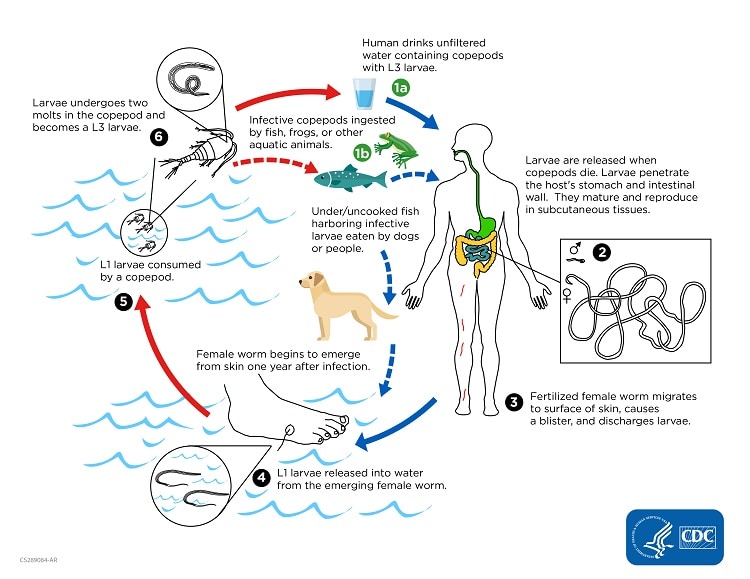Introduction
It is an infection of the subcutaneous and deeper tissues with a nematode measuring about a meter long. The vector of Guinea worm (water Cyclops) is found in stagnant water bodies rich in organic matter. In dry season in some areas for instance Northern and Volta regions of Ghana, ponds provide the only readily available source of water and therefore many people use it as their source of water.
The guinea worm disease has however been eradicated from Ghana. Anyone who reports a confirmed case is given GH¢ 200.
Causative organism: Nematode called Dracunculus medinensis
Incubation period: about 1 year
Mode of transmission: Through drinking of water contaminated with the larvae.
Lifecycle
The infection is caused by ingestion of water contaminated with water Cyclops (water snails) infected with the larvae. The larvae penetrate the human digestive tract wall, lodge in the loose connective tissues and mature into the adult form in 10-12 weeks.
In about a year, when the gravid female is ready to discharge larvae, it migrates to the subcutaneous tissues that normally come in contact with water. The cephalic end of the worm secrets a substance which causes a blister to form. When the blister comes into contact with water, the anterior end of the vagina protrudes and the uterus expels the larvae into the water. The larvae are picked up by Cyclops which then develop into infective form in 2-3 weeks.
 |
| Photo by CDC |
Diagnosis
It is diagnosed from the local blister or appearance of the worm from the skin.
Signs and Symptoms
- Fever and general malaise.
- Nausea and vomiting.
- Sometimes diarrhea.
- Burning and itching sensation of the area around the blister.
- Blister formation.
- Eventually blister ruptures and the worm may be seen.
Prevention
- Prevent people from drinking contaminated water.
- Treatment of all infected persons.
- Educate infected persons from entering ponds.
- Filter or boil susceptible water before drinking.
- Treating infected water with approved larvicides.
Treatment
- Treat with Metronidazole for five days. Other drugs are Mintezole and Vermox.
- Antibiotics can be giving to treat secondary bacterial infections.
- Winding the worm around the match stick and make sure not to break the worm to course serious infections.
Nursing Management
- Medication: give drugs as ordered. In case of fever and vomiting, you can give antipyretic and anti-emetics respectively.
- Squeezing the worm gently from the hole and winding it around a match stick a little more each day.
- Bath the affected part with cold water and apply cold compress for the worm to come out.
- Educate affected individuals not to enter sources of drinking water.
- Dress the worm daily and keep it clean.
- Surgery may be done to extract the worm under local anesthesia.
Read Also






1 Comments
I am pleased that this article provided me with some important information. Thank you so much for sharing it. Keep up the good work. Imaging Equipment Online Buy Usa
ReplyDelete